Physical Address
304 North Cardinal St.
Dorchester Center, MA 02124
Diffuse interstitial granulomatous pneumonitis, caused by exposure to inhaled organic antigens or other particles of small size in susceptible individuals
Large number of syndromes associated with specific triggering agents; major categories of agents include fungi, bacteria, and animal proteins
Worldwide distribution
Prevalence varies depending on geographic location and shows a seasonal variation for some syndromes
Exposures are occupational in some cases (eg, farmer’s lung, bagassosis, bird handler’s lung)
Low mortality
Morbidity depends on chronicity of exposure: prompt antigen withdrawal will produce improvement in most acute and subacute cases, whereas the prognosis is more variable in chronic cases
There is no predilection for specific gender, racial, or age groups, although HP is infrequent in children
Acute form presents as a flulike syndrome 4 to 5 hours after antigen exposure and is usually self-limited
Subacute and chronic forms present with chronic cough, dyspnea, and malaise for weeks or months (subacute) or months to years (chronic); exacerbations of cough and fever may be noted during exposure to antigens
Diagnosis is made on the basis of clinical history, biopsy, and exclusion of other entities in the differential diagnosis
Acute and subacute phases: bilateral ground-glass opacities and centriacinar nodules; the ground-glass infiltrates can be preferentially located in the centers of the secondary pulmonary lobules with relative sparing of the periphery
Chronic disease: variable degrees of interstitial fibrosis with a reticular pattern and/or honeycomb change
Acute and subacute forms usually resolve with antigen avoidance, and corticosteroid therapy is also administered to many patients to promote resolution
Chronic cases vary in the degree of interstitial fibrosis, so therapeutic response to antigen avoidance and corticosteroid therapy is more variable. Many patients, however, will experience improvement with these approaches
Acute phase: pattern of diffuse acute alveolar damage
Subacute phase: patchy consolidation with a predominantly centriacinar distribution
Chronic stage: patchy or more diffuse interstitial fibrosis with areas of honeycombing
Triad of interstitial pneumonitis (typically bronchiolocentric), cellular bronchiolitis, and poorly formed granulomas is seen in approximately 80% of patients; other patients may show only one or two of these features
Organizing pneumonia may be present
Alveolar collections of lipid-laden macrophages may be present
Obliterative bronchiolitis may be present
Increased CD8+ T-cells in BAL
Predominance of CD3+ CD8+ T-cells over CD4+ T-cells and B-cells
Infections
Sarcoidosis
Drug reactions with HP-like features
NSIP due to causes other than HP
UIP
Constrictive bronchiolitis (bronchiolitis obliterans)
Lymphoid interstitial pneumonia
Other bronchiolocentric interstitial lung diseases
Hypersensitivity pneumonitis (HP) is also known as extrinsic allergic alveolitis. It can be defined as a diffuse interstitial granulomatous pneumonitis triggered by exposure to inhaled antigens (mold, bacteria, animal proteins, insect proteins) or other sometimes unknown allergen particles of small size (5 μm or smaller) in susceptible individuals. Although the list of antigens that could potentially serve as stimuli for this reaction is limitless, the individual must be immunologically reactive to the agent for the disease to develop, and exposure to the agent is necessary. The disease may be known by a great variety of names depending on the causal agent (farmer’s lung, pigeon breeder’s disease, ventilation pneumonitis, etc.), but the clinical presentations and pathologic findings are similar, regardless of the identity of the responsible antigen. A combination of types III and IV hypersensitivity reactions is believed to account for the pathogenesis of this condition.
Patients with HP can present with an acute, subacute, or chronic clinical picture. A patient with acute HP may report a history of abrupt onset (4–6 hours after exposure) of a flulike syndrome with fever, malaise, chills, diaphoresis, headache, nonproductive cough, and dyspnea. There is peripheral blood leukocytosis with neutrophilia, but eosinophilia is usually not seen. These symptoms resolve without specific treatment in 1 to 3 days, but can recur with repeated exposures to the triggering agent. The subacute form of the disease is more difficult to define: usually these patients have had a history consistent with HP for several months, with one or more previous acute exacerbations of the disease. Patients with chronic HP present with progressive dyspnea, cough, weight loss, and anorexia, developing over a period of months or years. Some patients will recognize acute symptoms after exposures to the antigen, whereas others may notice a more insidious onset of dyspnea.
Plain films of the chest may show parenchymal changes that become better defined on high-resolution computed tomography (HRCT) scan. HRCT during the acute and subacute phases shows bilateral ground-glass opacities and centriacinar nodules. The ground-glass infiltrates can be preferentially located in the centers of the secondary pulmonary lobules with relative sparing of the periphery. If small-airway obstruction is present, air trapping can be seen on expiratory HRCT as a mosaic pattern. Patients with chronic disease show a radiologic appearance that will depend on the degree of interstitial fibrosis, with a reticular pattern.
Only a few cases of acute HP have been described because the disease is usually not fatal during early stages, and the appearance that has been described is that of acute diffuse alveolar damage (DAD). In the subacute stage, there may be irregular areas of consolidation that tend to be centriacinar in distribution. The chronic stage has been well described and consists of interstitial fibrosis with honeycomb change in areas.
Lung biopsies are usually obtained from patients with subacute or chronic disease, whereas acute HP is less often seen in surgical pathology material because the diagnosis may be made clinically. The histopathology of acute farmer’s lung has been described as that of acute DAD. Cases of acute HP or acute exacerbation of HP have been described as having features of subacute HP and acute fibrinous and organizing pneumonia. The histopathology of the subacute and chronic manifestations of HP is well known: there is a typically bronchiolocentric interstitial pneumonitis ( Fig. 17.1 ), with interstitial lymphoplasmacytic infiltrates ( Fig. 17.2 ), cellular bronchiolitis, and poorly formed (loose), nonnecrotizing granulomas. Isolated giant cells ( Fig. 17.2 ) with occasional cholesterol clefts and Schaumann bodies may be found. As a rule, these granulomas are small and poorly defined. Stains for microorganisms (fungi, acid-fast organisms) will usually not reveal these agents. Obliterative bronchiolitis can also be seen in occasional examples.
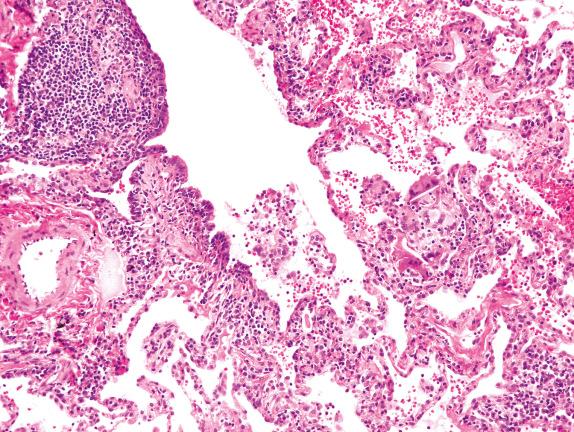
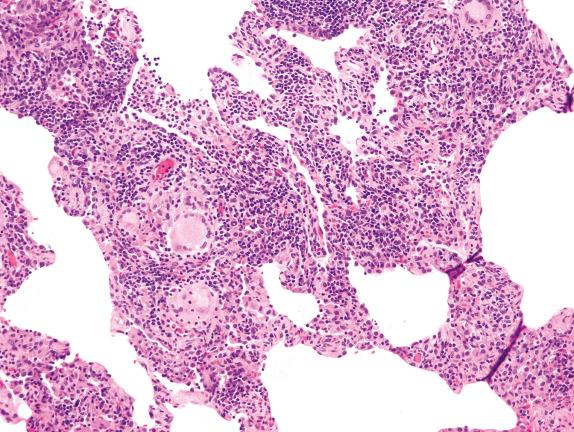
Although the triad of interstitial pneumonitis, cellular bronchiolitis, and ill-defined granulomas is seen in 80% of the well-documented cases of HP, some cases will demonstrate only one or two of these features, and in these cases, it is particularly important to demonstrate a linkage between exacerbations and exposures to the triggering agent. Occasional areas of organizing pneumonia are commonly seen ( Fig. 17.3 ) in combination with the other findings. In some cases, there are collections of foamy macrophages ( Fig. 17.4 ), which may represent small foci of endogenous lipid pneumonia, although it has been suggested that some antigens (such as those seen in pigeon breeder’s disease) may exist in some of these foamy cells. If exposure to the inciting antigen is avoided, the granulomatous lesions resolve in 4 to 6 months, but persistent exposure results in progression of the disease to interstitial fibrosis that may resemble a nonspecific interstitial pneumonia (NSIP) or usual interstitial pneumonia (UIP) pattern.
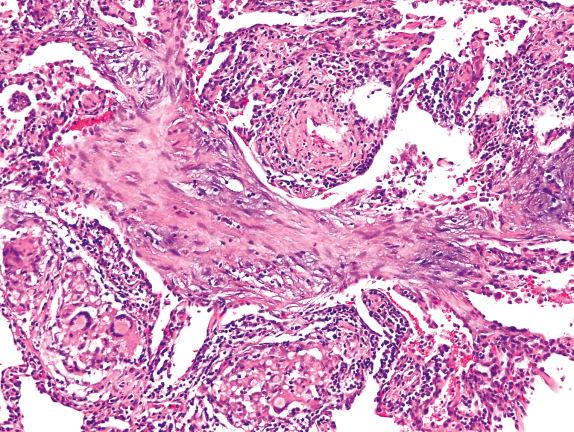
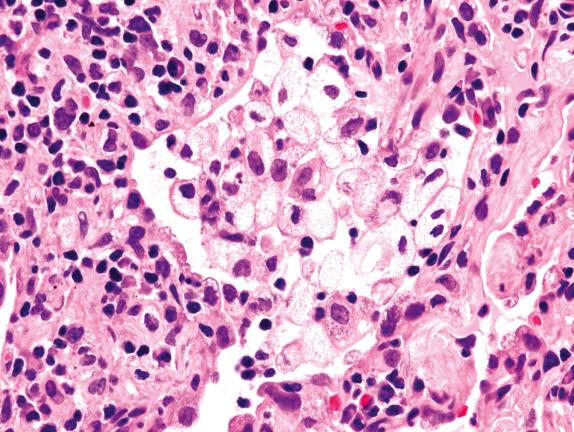
Bronchoalveolar lavage (BAL) characteristically shows increased CD8+ T-cells.
There is a predominance of CD3+ CD8+ T-cells over CD4+ T-cells and B-cells.
The differential diagnosis for HP includes many diffuse interstitial lung diseases, including infections, sarcoidosis, constrictive bronchiolitis, UIP, NSIP, and other bronchiolocentric interstitial lung diseases. Infections, particularly due to mycobacterial, fungal, and respiratory viruses, should always be ruled out by cultures, special stains, and clinical correlation. Hot tub lung is caused by a mycobacterial infection ( Mycobacterium avium complex) and histologically resembles HP, but cultures demonstrate the organism. Sarcoidosis is usually associated with well-formed granulomas that follow the lymphatic routes. Constrictive bronchiolitis (bronchiolitis obliterans) can be caused by other types of lung injury, as well as HP, and manifests dense subepithelial fibrosis in bronchioles, causing luminal obstruction. Variable degrees of inflammation can accompany the fibrosis, but there is usually little or no interstitial pneumonia, and granulomas are absent in non–HP-associated cases. The cellular pattern of NSIP can be seen in patients with a history of exposure to organic antigens. The pathologist should keep in mind that NSIP is a histologic pattern, and although it can be idiopathic, some well-documented cases of HP have been associated with a biopsy diagnosis of NSIP. Drugs such as mesalamine, methotrexate, and others can also serve as stimuli for reactions that have features of HP, usually NSIP and granulomas. The differential diagnosis should also include lymphoid interstitial pneumonia in cases in which the lymphocytic infiltrate is very prominent. In rare cases, lymphocytic interstitial pneumonia can be a manifestation of HP.
The long-term prognosis of patients with HP depends on several factors, including the type and duration of antigen exposure and the response of the individual to immunologic injury. Acute and subacute cases, in which the offending antigen is identified and avoided and the patient receives adequate treatment, generally show a good prognosis. Corticosteroids are a mainstay of therapy and will produce improvement in most subacute and chronic cases. A subset of patients with chronic HP, however, will have developed significant interstitial fibrosis by the time the diagnosis is made, and these individuals may not respond to either corticosteroids or avoidance of the responsible agent.
Sarcoidosis is a multisystem granulomatous disease of unknown etiology that is characterized pathologically by the presence of nonnecrotizing granulomas
Worldwide distribution
Prevalence of 10–40 per 100,000 is reported in the United States and Europe
Death attributable directly to the disease is seen in up to 10% of those affected
In most individuals, the disease remains relatively stable, but 10%–30% of patients have a progressive course
Females are slightly more often affected than males
In the United States, the prevalence is higher in African Americans, but in Europe the disease primarily affects Caucasians
Rare among Inuit, Canadian Indians, New Zealand Maoris, and Southeast Asians and in several countries of Latin America
Most common in middle age
Dyspnea and cough are associated with lung parenchymal involvement
Other symptoms depend on the organ systems involved and the severity of involvement
Presentation depends on the stage of the disease
Hilar lymphadenopathy and interstitial reticular, reticulonodular, or nodular infiltrates, often following lymphatic routes, are typical
Pleural effusion in 10% of cases
Nodular sarcoidosis is an uncommon variant that presents with nodules up to 5 cm in diameter, which may be cavitary
Spontaneous remissions in a large number of patients
Chronic progressive disease in 10%–30%
Mortality rates up to 10% have been reported
Corticosteroids may have some benefit, but long-term, durable benefits have not been seen
A variety of second-line agents is available
Changes may be minimal in early disease, but with progression, yellowish nodules may be visible along the interlobular septa and bronchovascular areas
In advanced disease, there is diffuse interstitial fibrosis and honeycomb change
Involved lymph nodes may demonstrate replacement by yellowish nodules or fibrosis
Multiple well-circumscribed, nonnecrotizing granulomas in multiple organs
Granulomas tend to show a lymphangitic and perivascular distribution in the lung
Granulomatous vasculitis may be present
Although granulomas are typically nonnecrotizing, small foci of necrosis in granulomas are not uncommon
No microorganisms identified on acid-fast and fungal stains
Granulomatous infections, particularly mycobacterial and fungal infections
HP
Drug reactions
GPA
Sarcoidosis is a multisystem granulomatous disease of unknown etiology that is characterized pathologically by the presence of nonnecrotizing granulomas. The minimal criteria for a diagnosis of sarcoidosis include consistent clinical features, the histologic finding of nonnecrotizing granulomas, and exclusion of other potential etiologies that may explain the granulomatous inflammation. Sarcoidosis represents an exaggerated Th1-type immune response that is probably triggered by an antigen or antigens at sites of disease activity. Although many potential antigenic causes have been studied, none has yet been conclusively proven to be responsible for the disease. There is some evidence, however, suggesting a role for infectious agents, especially mycobacteria and propionibacteria, in the pathogenesis. Recent case reports and clinical trials have also reported efficacy of antimicrobial therapy on cutaneous and pulmonary sarcoidosis. The disease is thought to be multifactorial, with a genetic predisposition determined by the varying effects of several genes and the interaction of the susceptible host with environmental agents. There is significant heterogeneity in disease presentation and severity among different ethnic and racial groups and a linkage to specific human leukocyte antigen (HLA) types. Several alleles seem to confer susceptibility to disease (HLA DR 11, 12, 14, 15, 17) and some that seem to be protective (HLA DR1, DR4, and possibly HLA-DQB1∗0201).
The lung and hilar lymph nodes represent the most common sites of involvement by sarcoidosis. Symptoms resulting from parenchymal lung involvement include dyspnea and cough. Pulmonary function abnormalities are found in nearly all symptomatic patients and in some patients who are asymptomatic. Physiologic abnormalities in patients with symptomatic sarcoidosis typically consist of a reduction in diffusing capacity of the lungs for carbon monoxide (DLCO) and vital capacity without airflow obstruction. The DLCO typically becomes abnormal before the vital capacity becomes abnormal, but both are usually affected in persons with moderate or severe symptoms. Airflow obstruction is relatively uncommon except in patients with advanced disease or with endobronchial involvement of larger airways. In rare instances, diffuse endobronchial granulomas in small airways lead to a predominantly obstructive pattern.
Intrathoracic sarcoidosis is diagnosed most easily by bronchoscopy with lung biopsy. The yield of bronchoscopic biopsy depends on the radiographic stage. In patients with pulmonary infiltrates, bronchoscopic lung biopsy demonstrates nonnecrotizing granulomas in approximately 90% of cases. In stage I disease, the yield is 60% to 70%. If a diagnosis is not established by bronchoscopy and lung biopsy, mediastinoscopy is indicated and will provide a diagnosis in over 95% of cases in which mediastinal adenopathy is present. Fine-needle aspiration procedures can also be useful for retrieving granulomas and when used with either endobronchial or transbronchial biopsies can improve the yield to over 90%. Biopsy of extrapulmonary tissues can be performed for diagnosis when clinically indicated (eg, in patients with peripheral lymph node enlargement or skin lesions).
Sarcoidosis is characterized by bilateral hilar lymphadenopathy and diffuse infiltrative lung disease. The changes have been classified according to a five-stage system as follows: stage 0, normal chest radiograph (8% of cases at presentation); stage I, bilateral hilar lymphadenopathy alone (40% of cases); stage II, bilateral hilar lymphadenopathy and diffuse infiltrative lung disease (37% of cases); stage III, diffuse infiltrative lung disease alone (10% of cases); and stage IV, lung fibrosis, often with upper lobe cystic disease (5% of cases).
The gross findings depend on the stage of the disease. Yellowish nodules corresponding to granulomas can be seen along the interlobular septa and bronchovascular areas of the lung, as well as on a cut section of involved lymph nodes. In advanced stages, interstitial fibrosis and honeycomb changes can develop. When the granulomas cluster and form clinical masses in the lung, the term nodular sarcoidosis is often used. These masses, which may be as large as 5 to 7 cm, can be multiple and bilateral and mimic neoplasms on imaging studies. This entity is considered a type of sarcoidosis and has no prognostic or therapeutic significance.
The classical histopathologic lesion in sarcoidosis is the nonnecrotizing granuloma. Granulomas are usually small, compact, well circumscribed ( Fig. 17.5 ), generally unassociated with diffuse interstitial pneumonitis (unlike HP), and often follow lymphatic and bronchovascular routes ( Figs. 17.6 and 17.7 ). Granulomas can often be found in the bronchial mucosa, accounting for the high percentage of cases that can be diagnosed by bronchoscopic lung biopsy ( Fig. 17.8 ). Granulomatous angiitis is another occasional manifestation of sarcoidosis ( Fig. 17.9 ). When granulomatous angiitis and ischemic-type necrosis are present in a nodular sarcoidosis, a diagnosis of necrotizing sarcoid granulomatosis should be considered (see Chapter 8 ).
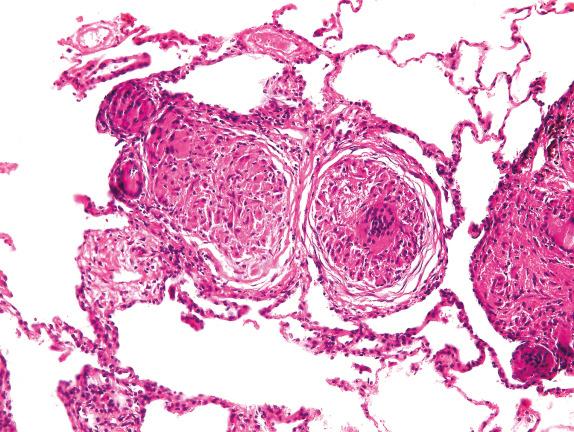
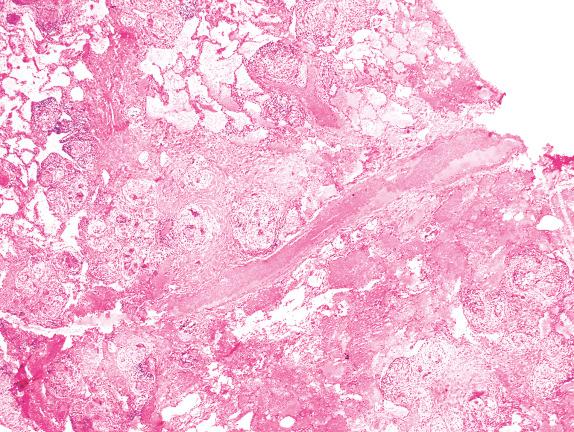
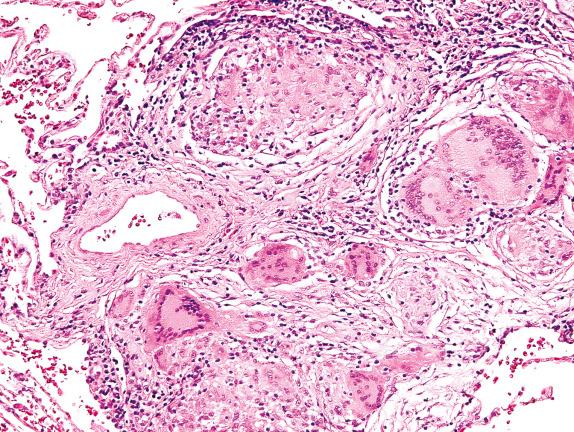
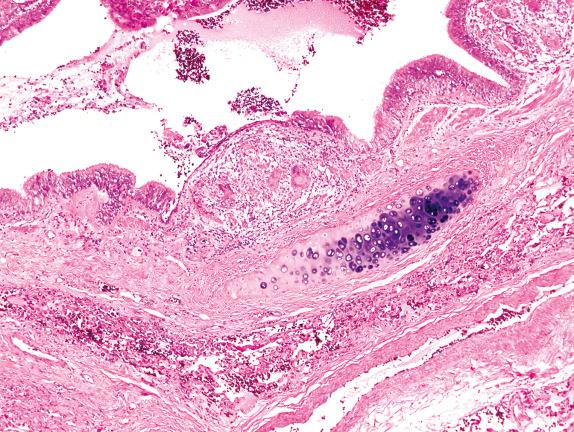
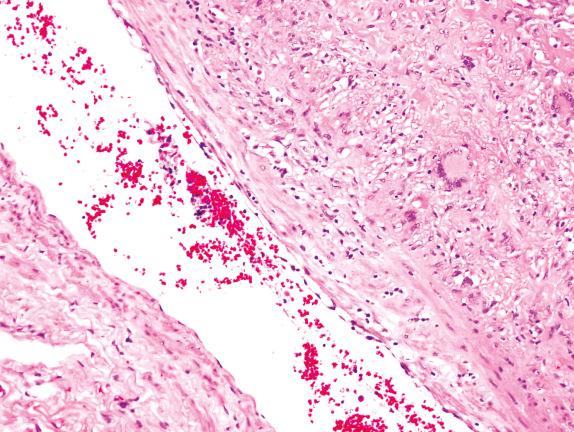
Although the granulomas in sarcoidosis are usually described as nonnecrotizing, small foci of necrosis have been reported in 6% to 39% of cases. Schaumann bodies, also known as conchoidal bodies, are lamellated calcifications that are often seen in giant cells in the sarcoidal granulomas, as well as other types of granulomatous lesions. Asteroid bodies are seen in 2% to 9% of granulomas from patients with sarcoidosis; these structures are seen within giant cells and consist of 5- to 30-μm stellate inclusions with numerous rays radiating from a central core. Oxalate crystals, which are birefringent under polarized light, may also be found. Over time, the granulomas become hyalinized ( Fig. 17.10 ), and dense interstitial fibrosis can develop. Stains for acid-fast organisms and fungi should be performed, and the lack of organisms visible on these stains forms a key component of the diagnosis.
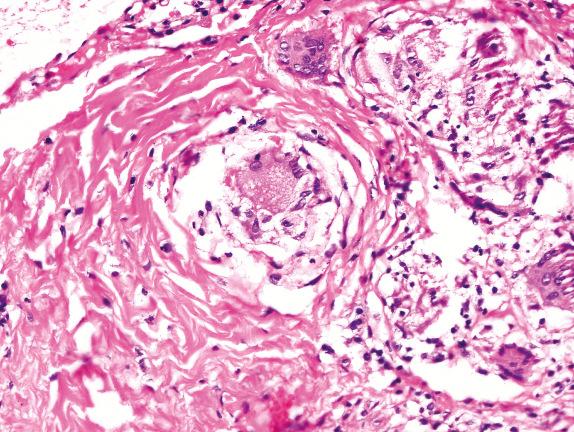
Cytology samples, especially needle aspirates, may yield nonnecrotizing granulomas ( Fig. 17.11 ).
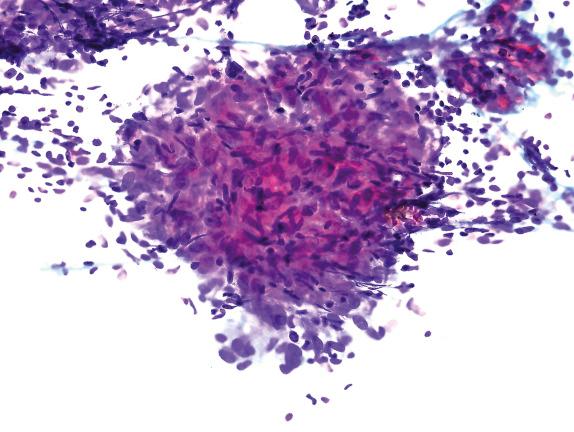
The differential diagnosis includes other granulomatous pulmonary disorders. Demonstration of an infectious agent in a granuloma by a special stain precludes a diagnosis of sarcoidosis. Similarly, isolation of a compatible agent by culture should deter one from a diagnosis of sarcoidosis. In HP, granulomas are usually more poorly formed than in sarcoidosis and are usually accompanied by interstitial pneumonia and cellular bronchiolitis. Small, well-circumscribed nonnecrotizing sarcoidal granulomas are exceedingly uncommon in granulomatosis with polyangiitis (GPA), which is characterized by vasculitis and zones of geographic necrosis with granulomatous rims. Recently, interferon therapy has been associated with development of a granulomatous reaction that is histologically similar to sarcoidosis. Other drugs can also potentially produce a granulomatous pneumonitis, but the pattern is usually more like HP than sarcoidosis. Finally, berylliosis, an uncommon occupational lung disease associated with exposure to beryllium, manifests a granulomatous reaction pattern similar to sarcoidosis, but patients will have a history of exposure to the substance.
The natural history of sarcoidosis is highly variable. In 60% to 70% of all cases, spontaneous remission will occur, and in 10% to 30%, the disease will follow a progressive course. The mortality rate is up to 10%, and death usually results from progressive lung disease, neurosarcoidosis, or cardiac disease. Other adverse prognostic features include chronic uveitis, onset after 40 years of age, hypercalcemia or nephrocalcinosis, nasal mucosal involvement, and cystic bone disease.
The treatment of patients with sarcoidosis has been a controversial issue. Many patients have mild disease that does not require systemic treatment. Clinical trials have clearly shown some differences in steroid treated versus untreated groups, but overall, corticosteroids do not seem to induce significant long-term durable benefits when used as routine therapy. Methotrexate, leflunomide, azathioprine, mycophenolate, infliximab, adalimumab, and hydroxychloroquine, among others, are used as second-line agents for symptomatic sarcoidosis.
Rare, diffuse infiltrative lung disease representing a low-grade neoplastic proliferation of modified smooth muscle cells, occurring as a sporadic disease or as a component of tuberous sclerosis complex
Ten-year survival of 91% from onset of symptoms
Usually progressive and associated with increasing respiratory disability
Complications include chylothorax and pneumothorax
Become a Clinical Tree membership for Full access and enjoy Unlimited articles
If you are a member. Log in here